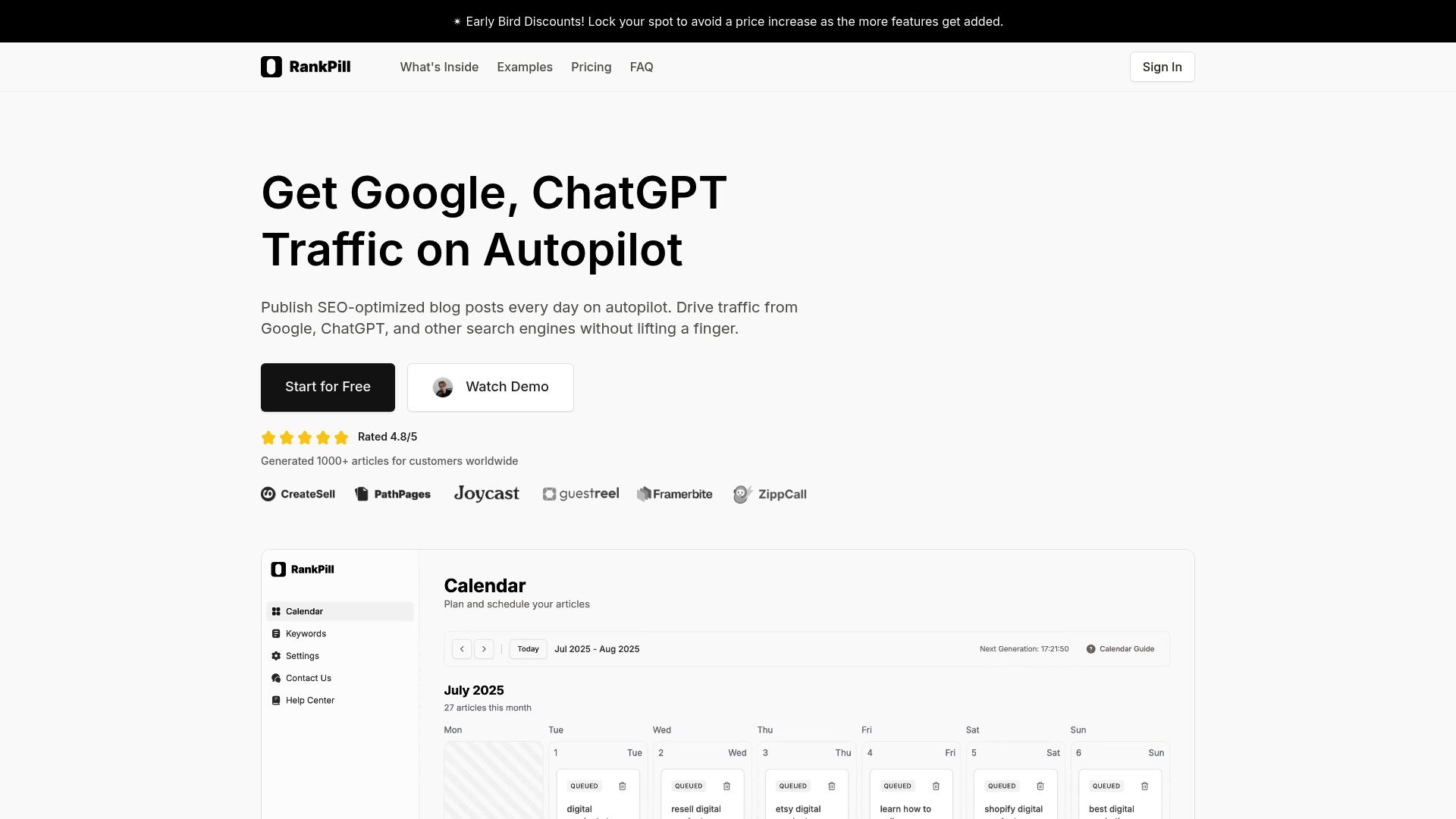Organic SEO is entering a new era—competition is fiercer, and the rules are evolving faster than ever as we head into 2025. For businesses and creators, keeping up with these seismic shifts is crucial to staying visible online.
This guide gives you a proven roadmap to master organic SEO, ensuring your website gains lasting search visibility and steady traffic growth. Expect actionable, expert-backed strategies you can implement right away.
You'll learn what organic SEO means today, which ranking factors matter most, how to optimize step by step, advanced tactics, ways to measure results, and trends to future-proof your efforts.
What Is Organic SEO and Why It Matters in 2025
Understanding organic SEO is essential for anyone looking to build sustainable online visibility in 2025. Organic SEO refers to the process of optimizing your website to appear in unpaid, algorithm-driven search results. Unlike paid search (PPC), where businesses pay for placement, organic SEO focuses on earning top positions through high-quality, relevant content and technical optimization. For example, if you search “personal loans,” you’ll see a mix of paid ads at the top and organic results below. The difference is clear: organic SEO brings in traffic that’s earned, not bought. For a deeper dive into how this traffic works, see What is organic search traffic. Ultimately, organic SEO is what drives lasting, cost-effective website visits from users genuinely interested in your offerings.

Defining Organic SEO
Organic SEO is all about earning search engine rankings naturally, without paying for ads. It relies on optimizing website content, structure, and authority to satisfy search algorithms and user intent. In contrast, paid search (PPC) allows businesses to appear instantly at the top of results for a fee, but this traffic disappears once the budget runs out.
A quick comparison:
| Feature | Organic SEO | Paid Search (PPC) |
|---|---|---|
| Cost | Ongoing investment | Pay per click |
| Longevity | Sustainable traffic | Stops with budget |
| Trust | Perceived as higher | Lower trust |
High-quality content is the cornerstone of organic SEO, helping you appear where your audience is searching. Unlike other traffic sources, organic SEO builds authority and attracts users who trust your expertise.
The Business Value of Organic SEO
Organic SEO is a powerhouse for business growth. On mobile devices, the first organic result captures roughly 22% of all clicks, according to Semrush. This means organic SEO provides a consistent stream of qualified visitors, often at a lower cost than paid ads.
It’s not just about traffic—organic SEO also builds brand visibility, trust, and long-term authority. Take Gymshark, for example: their website attracts over 2 million monthly visitors from more than 25,000 keywords, all from organic search. Unlike paid campaigns, organic SEO keeps delivering results even after your initial investment.
When you invest in organic SEO, you’re setting up your business for sustainable, compounding growth that doesn’t rely on ad spend.
Key Benefits and Challenges
Organic SEO offers several compelling benefits:
- Increased brand recognition and credibility
- Sustainable, long-term traffic growth
- Higher conversion rates from qualified leads
However, it’s not without challenges. Search algorithms evolve frequently, making it tough to keep up. Competition is fierce, especially for new sites. Results can be slow to materialize, requiring patience and persistence.
SERP features like featured snippets and ads often push organic results further down the page, making visibility harder to achieve. Despite these hurdles, organic SEO consistently delivers a stronger ROI than most other channels, making adaptability crucial as we move into 2025.
Trends Shaping Organic SEO in 2025
The landscape of organic SEO is constantly evolving. In 2025, AI-driven search features like Google’s AI Overviews are transforming how results are displayed. There’s a growing emphasis on E-E-A-T: Experience, Expertise, Authoritativeness, and Trustworthiness.
SERP features such as featured snippets and People Also Ask continue to gain prominence, capturing clicks that once went to traditional listings. User experience, Core Web Vitals, and mobile optimization are more important than ever.
To stay competitive, brands must adopt holistic, multi-channel strategies that integrate content, technical improvements, and off-site signals. Keeping pace with these trends is key for organic SEO success in the coming year.
Core Ranking Factors for Organic SEO Success in 2025
Mastering organic seo in 2025 means understanding the evolving ranking factors that search engines value most. As Google’s algorithms become more sophisticated, a holistic approach that balances content, authority, technical health, and user experience is essential for lasting visibility.

Content Quality and Relevance
High-quality, relevant content remains the cornerstone of organic seo success. Google prioritizes helpful, original material that directly addresses user intent. To rank well, your content must answer the searcher’s questions better than competitors, using clear structure and engaging elements.
For instance, analyzing the intent behind “best running shoes for beginners” reveals users want practical recommendations and buying guidance, not just a product list. Adding structured data and rich media—like comparison tables or expert reviews—boosts both user satisfaction and ranking potential.
Data shows that content designed for people (not just algorithms) earns more backlinks and shares. Incorporate visuals, FAQs, and up-to-date information to stand out. In 2025, refining your content for both depth and intent alignment is non-negotiable for organic seo.
Authority and Backlinks
Authority is built through a strong backlink profile. Backlinks act as votes of confidence, signaling to Google that your site is trustworthy and valuable for organic seo. Recent studies reveal top-ranking pages average thousands of quality backlinks, but not all links are created equal.
Focus on earning links from respected, relevant sources in your industry. Techniques like guest posting, digital PR, and creating link-worthy content pay off. For an in-depth look at proven tactics, see Building authoritative backlinks.
Quality always outweighs quantity. Regularly monitor your backlink profile to identify and disavow toxic links. By consistently pursuing reputable links, you strengthen organic seo authority and improve your chances of ranking higher.
Technical SEO and Site Usability
Technical optimization is fundamental for organic seo. Fast-loading sites that work flawlessly on mobile devices are favored by Google’s Core Web Vitals. Secure protocols (HTTPS), efficient crawlability, and clean site architecture ensure your content is accessible and indexable.
Use structured navigation and robust internal linking to guide both users and search engines. Implement schema markup to enhance your search listings with rich results. Regular technical audits—using tools like Semrush or Screaming Frog—help catch issues early and maintain site health.
A technically sound site not only supports organic seo rankings but also boosts user trust. Consistent optimization is key to staying ahead in 2025’s competitive landscape.
User Experience and Engagement Signals
User experience is a powerful ranking signal for organic seo. Google measures how users interact with your site—tracking metrics like click-through rates, dwell time, and bounce rates. Sites that engage visitors tend to rank higher.
Clear site structure and intuitive navigation make it easy for users to find what they need quickly. Engaging design, minimal distractions, and accessible features (like alt text and readable fonts) further enhance experience.
For example, sites with streamlined layouts and helpful content see better engagement and conversion rates. Prioritizing user experience ensures visitors stay longer and interact more, sending positive signals to Google about your organic seo value.
Step-by-Step Organic SEO Strategy for 2025
To master organic seo in 2025, you need a systematic approach built on proven fundamentals and new innovations. Let’s break down a step-by-step strategy that covers all the essentials, from keyword research to technical health. Each step focuses on real-world actions and measurable results.
Step 1: Advanced Keyword Research
Effective organic seo starts with smart keyword research. Use tools like Semrush and Ahrefs to find both primary and long-tail keywords that align with your business goals. Analyze competitor keyword profiles to spot gaps and new opportunities.
Focus on understanding search intent for each keyword. Are users looking for information, ready to buy, or comparing options? Use tools such as Google Ads Keyword Planner and AnswerThePublic to uncover what people are really searching for.
Regularly refresh your keyword lists based on seasonal trends and emerging topics. Don’t forget to check “People Also Ask” and related searches for fresh content ideas. Prioritize keywords with attainable difficulty, especially if your site is new. Building a strong keyword foundation fuels every other organic seo tactic.
Step 2: Creating High-Quality, Intent-Driven Content
Content is the backbone of organic seo. Start by researching the top-ranking pages for your target keywords. Note their structure, length, and the depth of information provided. Your goal is to create content that’s more helpful, comprehensive, and aligned with user intent.
Use clear headings, concise bullet points, and multimedia elements like images, infographics, or videos. Incorporate original research, expert quotes, and unique perspectives to stand out. Always cite credible sources and keep your information up to date.
Optimize your content for readability and skimmability. Break up dense sections, use short paragraphs, and update outdated posts regularly. The more value your content delivers, the more likely it is to earn shares, backlinks, and top organic seo rankings.
Step 3: On-Page SEO Optimization
On-page optimization is critical for organic seo success. Begin by crafting compelling title tags and meta descriptions that include your target keywords. Keep URL slugs short, descriptive, and keyword-rich.
Structure your content with H1, H2, and H3 headings to improve readability and SEO. Use primary and secondary keywords naturally throughout the body text. Internal links to related articles and cornerstone content help search engines understand your site’s structure.
Add descriptive alt text to all images for accessibility and additional ranking signals. Avoid keyword stuffing—focus on natural language and a smooth flow. Use on-page SEO checkers to catch missed opportunities and ensure every page is fully optimized for organic seo.
How AI Platforms Like RankPill Accelerate Organic SEO
AI is transforming organic seo by automating time-consuming tasks. Platforms like RankPill handle keyword research, content creation, and optimization with remarkable efficiency. They generate daily SEO-optimized articles, conduct competitor analysis, and even auto-publish to your website.

For non-technical users, small businesses, and startups, AI tools can level the playing field. RankPill’s real-time SEO scoring ensures that every piece of content aligns with the latest best practices. Features like automated image and video insertion, plus smart internal linking, further boost results.
If you’re exploring modern content strategies, learn more about content creation with AI for SEO to see how these platforms can drive consistent organic seo growth while saving time and resources.
Step 4: Building Authoritative Backlinks
Backlinks remain a pillar of organic seo. Start by analyzing your competitors’ backlink profiles to identify sites that link to them but not you. Use strategies like:
- Guest posting on reputable blogs
- Responding to HARO (Help a Reporter Out) queries
- Broken link building by offering your content as a replacement
- Creating linkable assets like in-depth guides or data studies
Turn unlinked brand mentions into backlinks by reaching out to site owners. Focus on earning links from high-authority, relevant domains rather than chasing sheer quantity. Regularly monitor your backlink profile for toxic links and disavow them to maintain a healthy link reputation.
Building relationships with industry influencers can also unlock new backlink opportunities. Remember, quality backlinks are a direct signal of authority for organic seo.
Step 5: Technical SEO and Site Health
A healthy technical foundation is essential for organic seo success. Perform regular site audits using tools like Semrush or Screaming Frog to catch crawl errors, broken links, and duplicate content. Optimize site speed with image compression, browser caching, and minimal scripts to meet Core Web Vitals.
Make sure your site is mobile-friendly and fully responsive. Use HTTPS for security and structured data/schema for enhanced SERP features. Create and submit XML sitemaps, and configure robots.txt to guide search engine crawlers.
Technical issues can quickly erode rankings, so address them promptly. By prioritizing site health, you ensure that all your other organic seo efforts deliver maximum impact.
Advanced Organic SEO Tactics for 2025
Staying ahead with organic seo in 2025 means adopting advanced tactics that go beyond the basics. As search algorithms evolve, it’s essential to future-proof your strategy and deliver value that stands out in competitive SERPs. Below, we’ll explore the cutting-edge moves shaping organic seo success this year.

Optimizing for SERP Features and AI Overviews
To maximize organic seo visibility in 2025, you must target SERP features like featured snippets, People Also Ask boxes, and knowledge panels. Google’s AI Overviews are changing how users see information—so structuring your content for concise, direct answers is critical.
- Create FAQ sections to answer common questions.
- Use schema markup to qualify for enhanced SERP displays.
- Format lists, tables, and definitions for snippet capture.
A practical approach is to monitor SERP layouts for your target keywords and adjust accordingly. For more on which factors impact these features, see the Top Google Ranking Factors in 2025. Adapting to these shifts ensures your organic seo efforts reach users where it matters most.
Leveraging Topical Authority and Content Hubs
Building topical authority is now a must for organic seo dominance. Instead of scattered posts, create comprehensive content hubs around core topics. This signals depth and expertise to search engines.
- Develop pillar pages that link to detailed subtopics.
- Cover a range of user questions and related themes.
- Regularly update content to maintain authority.
For example, a “running shoes” hub might include buyer’s guides, reviews, and care tips, all interlinked. This approach helps your site compete with larger brands and builds a reputation for expertise in your niche. Topical authority will increasingly influence organic seo rankings as algorithms get smarter.
Enhancing Content with Multimedia and Interactivity
Rich media is vital for engaging users—and for organic seo performance. Adding images, infographics, videos, or interactive tools like quizzes keeps visitors on your page longer.
- Use alt text and descriptive file names for all media.
- Embed video summaries or interactive checklists to boost engagement.
- Ensure every element is optimized for mobile devices.
Data shows that pages with multimedia elements achieve higher engagement rates, which can indirectly benefit rankings. By integrating interactive features, you also make your organic seo content more memorable and shareable, setting your site apart from static competitors.
Local and Mobile SEO Optimization
Local and mobile optimization is a game changer for organic seo, especially as mobile searches now represent over 60% of all queries. Ensure your Google Business Profile is up-to-date and your site is fully responsive.
- Use location-based keywords and locally relevant content.
- Encourage customer reviews to enhance trust signals.
- Implement local business schema for better visibility in map packs.
Being visible in mobile and local results can drive targeted traffic to your business. Prioritizing these elements ensures your organic seo strategy captures users at every stage of the buying journey, wherever they are.
Future-Proofing Against Algorithm Updates
The only constant in organic seo is change. Google’s algorithm updates can shift rankings overnight, so staying agile is crucial. Monitor industry news, update content regularly, and diversify your traffic sources.
- Focus on evergreen topics and continuous content improvement.
- Build a strong brand presence both on and off your site.
- Act fast to recover from ranking volatility and refine your tactics.
To stay ahead of future shifts, explore the Future trends in SEO. By anticipating changes and continuously optimizing, you’ll ensure your organic seo strategy remains resilient and effective in 2025 and beyond.
Measuring, Analyzing, and Refining Your Organic SEO Performance
Understanding how to measure, analyze, and refine your organic seo efforts is key to dominating the search landscape in 2025. With data-driven decisions, you can uncover growth opportunities, fix weaknesses, and stay ahead of competitors. Let’s break down a practical approach to ongoing organic seo success, step by step.
Setting Up SEO Tracking and Analytics
Start by laying a solid measurement foundation for your organic seo. Use Google Analytics and Google Search Console to monitor organic traffic, keyword rankings, and site health.
Key metrics to track include:
- Organic traffic growth
- Keyword rankings and visibility
- Click-through rates (CTR)
- Bounce rates and dwell time
- Conversion rates from organic seo
Set up conversion goals and events to link organic seo to business outcomes. Benchmark your data regularly against competitors. For a deeper understanding of what to track, consult Google's 200 Ranking Factors for a comprehensive list of what influences rankings. These insights help you prioritize your analytics setup for maximum impact.
Interpreting Data and Identifying Opportunities
Once you’re tracking the right metrics, it’s time to dig into the data. Analyze organic seo traffic patterns and user behavior to identify what’s working—and what needs attention.
Look for:
- Content gaps where competitors rank but you don’t
- High-exit or low-converting pages to optimize
- Keyword opportunities from rising trends
- Backlink profile growth and quality
Tools like heatmaps and session recordings reveal how users interact with your content. By studying these signals, you can pinpoint areas for improvement. This process turns raw numbers into actionable insights that move your organic seo forward.
Continuous Optimization and Content Refresh
Organic seo isn’t a set-it-and-forget-it strategy. Regularly update high-performing pages, refresh older content, and test new formats or calls-to-action.
Key steps for ongoing improvement:
- Repurpose evergreen content with new data or examples
- Address declining rankings with updated SEO best practices
- Experiment with headlines, layouts, and interactive elements
- Schedule periodic site audits to catch technical issues
Refreshing your content keeps your site relevant, which is critical for organic seo in a fast-changing environment. Small, consistent tweaks can make a big difference in traffic and conversions.
Staying Ahead: Tools and Resources for Ongoing Success
To maintain organic seo momentum, stay plugged into the latest tools, resources, and trends. Invest in platforms like Semrush, Ahrefs, or Screaming Frog for deep analysis and competitor insights.
Keep learning by:
- Following SEO thought leaders and communities
- Attending webinars and industry conferences
- Subscribing to Google’s official updates
Staying informed about The 2025 Google Algorithm Ranking Factors helps you anticipate changes and adapt quickly. Continuous education and proactive strategy are your keys to long-term organic seo dominance.
Ready to take your organic SEO game to the next level in 2025? We’ve covered the latest strategies and tools you’ll need to stand out, from mastering keyword research to building authority and leveraging AI for effortless content creation. If you want to put these tactics into action and see real results—without the overwhelm—there’s never been a better time to start. Let’s make your SEO work smarter, not harder. You can begin your journey toward consistent, sustainable traffic growth today by exploring how automation can simplify your workflow. Get Started